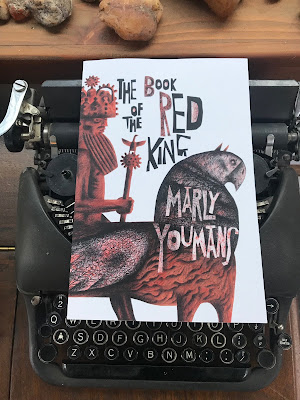 |
| Sweet little birds by Clive Hicks-Jenkins, made as extra decorations for French flaps |
Craving your very own Rollipoke? Fly here.
Seek Giacometti’s “The Palace at 4 a.m.” Go back two hours. See towers and curtain walls of matchsticks, marble, marbles, light, cloud at stasis. Walk in. The beggar queen is dreaming on her throne of words…You have arrived at the web home of Marly Youmans, maker of novels, poetry collections, and stories, as well as the occasional fantasy for younger readers.
 |
| Sweet little birds by Clive Hicks-Jenkins, made as extra decorations for French flaps |
 |
| Illumination by Clive Hicks-Jenkins for The Book of the Red King, 172 pp. (Montreal: Phoenicia Publishing, 2019) |
 |
| A few more images from Clive! |
 |
| Reliquary Bust of Saint Margaret of Antioch. Attributed to Nicolaus Gerhaert van Leyden (act. in Germany, 1462 - 73), Netherlandish. 1465-70. Walnut with traces of polychromy. Art Institute of Chicago. Wikipedia Commons. |
 |
| Image pilfered from Paul Pastor's twitter page @pauljpastor |
...the production is handsome, elegant and surprising. Mr. Hicks-Jenkins has done a grand job; his images and designs are in classy harmony with the spirit of the poems--as best as I can read them, anyhow.
I am content that he and [writer] Kelly [Cherry] have made better readings than I. She notes "a difficult and dangerous journey." I was not able to follow the progress of a journey--except through or over time, maybe. I read the volume as a nonsequential sequence and after some fanciful meditation thought of it as a sort of mystical, metaphysical board game with icon pieces: King, Fool, ideal Wentletrap, Alchemist, Flowers, Castle, Garden, and etc. as occasion required or suggested.
The game would be a little like chess and backgammon combined. Each poem is set in a new situation, the positioning of the pieces, their relationship to one another, determined by some shift of inner or outer circumstance. Each new situation requires on the part of Fool or King, a different new mode of perception--rather in the way that any movement of a piece on a chessboard generates and is contained by a new configuration of possible future moves. The Mere Fool sees things differently than does the Twelfth-night Fool; the Mere Fool is in quest of enlightenment; the Twelfth-night Fool experiences an epiphany which is not the result of his quest but which would be unavailable to him without that experience. The King of "Raptures" is very different indeed from the figure in "The Turret Stairs." And of course there are a number of poems in which both King and Fool appear and their perceptions / conceptions of the world are contrasted, though even in these the contrasts are not complete; often, in slant ways, they are complementary. King and Fool undertake very different ways of looking at the world and come (if they do) to very different conclusions, but these are not mutually exclusive--different but complementary, a little like logic and mathematics, perhaps. Although neither of them would be confused with a logician.
Nor will I, if you have been trying to comprehend this letter.
I have from line to line enjoyed and admired it unflaggingly. For it is as if I traversed a long gallery of separate dramatic moments: stately, antic, thoughtful, gay, gravid, artful, decorative, spontaneous, ritualized, reverent, satiric, learned and almost always to some degree playful. At times I thought, This book is the product of a metaphysician writing a series of comedy sketches. At other times, This is what happens when Pierrot philosophizes as a culture critic.
When I say "decorative" I mean no disrespect. For me Wallace Stevens is a decorative poet but supremely serious also and I might say the same of the paintings of Paul Klee. A lightsome approach can be most revealing--when it is rendered by a deft and practiced hand.
...maybe you can gather some estimate of my admiration and towering respect. This many-colored Paean to Imagination is unmatchable.I didn't need to put in a bit from the close, but I just love it, naturally enough!
 |
| Detail from artist Clive Hicks-Jenkins, cover for Charis in the World of Wonders |
 |
| Illumination by Clive Hicks-Jenkins of Wales Phoenicia Publishing, 2019 |
 |
October 5 Saturday 2:00 p.m.
Marly Youmans reading from The Book of the Red King
GREEN TOAD BOOKSTORE
198 Main St. Oneonta, NY 13820
(607) 433-8898
|
 |
| Clive Hicks-Jenkins vignette on Tomoe River paper for Charis in the World of Wonders |
 |
| Log House Antiques and Collectibles in Middletown, Virginia |
 |
| Preparatory sketch by Clive Hicks-Jenkins |
 |
| Interior and hardcover jacket or paperback cover art by Clive Hicks-Jenkins of Wales * * * Marly Youmans The Book of the Red King Montreal, Canada: Phoenicia Publishing (20 July 2019) * 155 pages |
 |
| Montreal: Phoenicia Publishing 155 pages |
 |
| Art by the great Clive Hicks-Jenkins of Wales. Design by Elizabeth Adams. |
 |
| Clive with St. George, the dragon, maiden, and his late, lamented little jackanapes... |